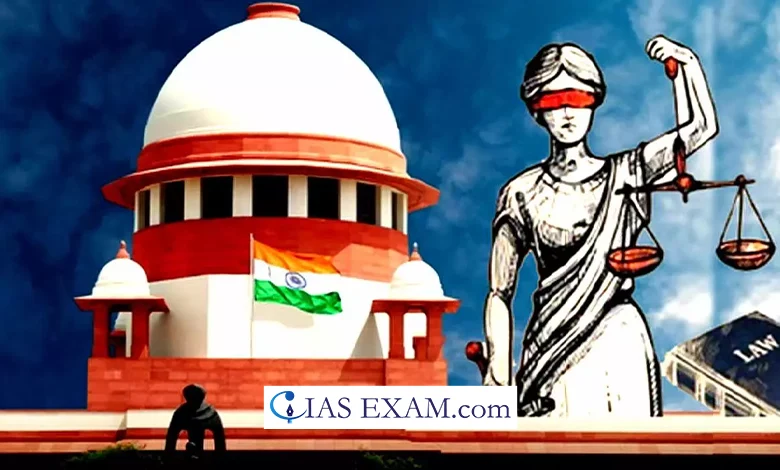Daily Current Affairs for UPSC
Reservation for Women in Bar Association Executive Committee
Syllabus - Polity [GS Paper-2]

Context
The Supreme Court has recently reserved one-third of the seats in the executive committee of the Supreme Court Bar Association (SCBA) for women.
Key Highlights
- The court directed that not less than 3 out of 9 seats in the executive committee and at least out of 6 senior executive members be reserved for women members of the Bar.
- The bench clarified that this reservation will no longer bar eligible women individuals from contesting for different posts as nicely, and directed that one post of the office-bearers of SCBA shall be completely reserved for women by turn and on a rotation basis.
- The reservation is only to guarantee a minimum and women members of the SCBA, according to their eligibility, shall be entitled to contest the election for all of the posts in the Executive Committee.
Supreme Court Bar Association
- The Supreme Court Bar Association (SCBA) in India is an organization comprising lawyers who are enrolled as contributors of the Supreme Court of India.
- It represents the pursuits of legal professionals practicing in the Supreme Court and aims to uphold the standards of the prison career and promote the management of justice.
- It also engages in activities aimed at improving the felony machine and protective the independence of the judiciary.
- The affiliation is ruled by its very own set of regulations and policies and elects workplace bearers to represent its participants and control its affairs.
Representation of Women in Judiciary
- Justice Beevi was the primary Muslim woman judge of the Supreme Court, also the first woman Supreme Court Justice in Asia in 1989.
- Since 1989, most effective 11 women have made it to the Supreme Court. Currently, there are only 3 women judges of the 33 Supreme Court judges.
- Only 4.1% of all Supreme Court judges have been women, even as the rest 96% are men.
- There are more women judges in the district court level than on the High Court level.
- Justice Nagarathna is in line to emerge as the first-ever woman Chief Justice of India in 2027.
- The appointment of Justices Kohli, Nagarathna, and Trivedi to the high court in 2021 created records, as this marked the first time that such a lot of women had been appointed to the SC.
- Earlier this year, the Supreme Court promoted 56 advocates as senior advocates, and out of these, 20 percent were women advocates.
- It was the first time in judicial history whilst 11 girls advocates have been given senior designation in a single move.
Reasons for the Lack of Representation of Women
- Historical Reasons: Historically, prison and judicial systems worldwide were men-dominated, and India is no exception. The legal career has historically been perceived as a men sector, and this attitude has persevered over the years.
- Societal Expectations and Stereotypes: Societal expectancies often dictate conventional gender roles, and there are stereotypes that strong women in roles which are visible as less like minded with the demands of a judicial profession.
- Educational Barriers: Limited instructional opportunities for girls result in fewer women applicants getting into the law profession and in the end pursuing a career in the judiciary.
- Family and Cultural Expectations: Cultural norms and expectancies regarding women’s duties within their own family dissuade them from pursuing stressful and time-consuming careers, consisting of a judicial career.
- Gender Bias and Discrimination: Stereotypes about women’s competencies lead to their exclusion from attention for higher judicial positions.
- Networking and Mentorship Opportunities: Male-dominated networks and mentorship structures within the legal career make it difficult for women to access the same opportunities for career options.
- Appointment Procedure: The lower judiciary has a higher representation of women than the High Court and Supreme Court.
- That’s possibly due to the fact access to the lower judiciary is through an examination, even as the High Court and Supreme Court are determined by the collegium.
Importance of Representation of Women in Judiciary
- Gender Equality: A diverse judiciary ensures a more inclusive and consultant legal system.
- Fairness and Impartiality: Having a judiciary that displays the diversity of the population facilitates in dispelling biases and promoting impartial choice-making.
- Inspiration and Role Modeling: Women judges can act as role models, encouraging greater women to pursue careers in regulation.
- Access to Justice for Women: Women can also feel more comfortable and understood when their instances are heard by judges who share equal life experiences and perspectives.
- Legal Interpretation and Legislation: Women judges can offer specific insights into criminal interpretation and the development of regulation, especially in areas related to gender- based problems, own family regulation, and women’s rights.
- Their presence can impact prison discourse and make contributions to the evolution of more gender-sensitive legal guidelines.
- Global Norms and Commitments: Internationally, there’s a developing reputation of the significance of gender range in all sectors, consisting of the judiciary.
Conclusion
- The loss of illustration of women in the judiciary, blended with the conventional exclusionary attitude in women, has led to a lack of diversity in the judicial gadget.
- Therefore, it’s critical that efforts to increase diversity in the judiciary are made to make certain a more equitable court.
- There is a requirement to decorate transparency in the judicial device.
Source: The Indian Express
UPSC Mains Practice Question
Q.What are the continued challenges for women in India against time and space?(2019)





.png)



